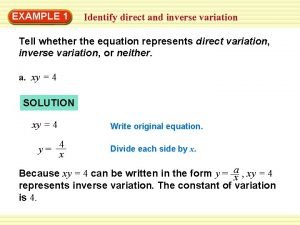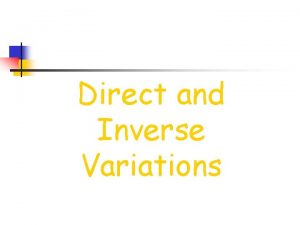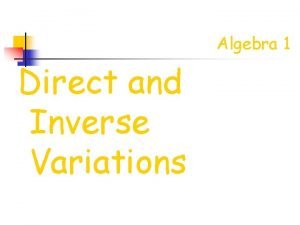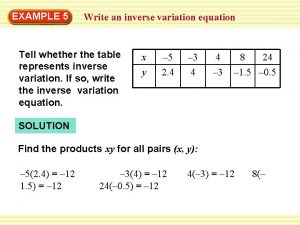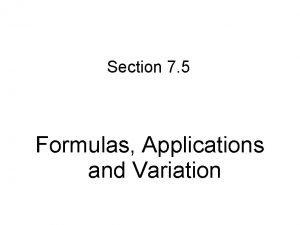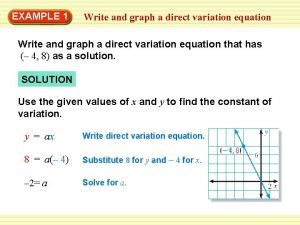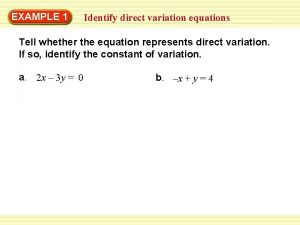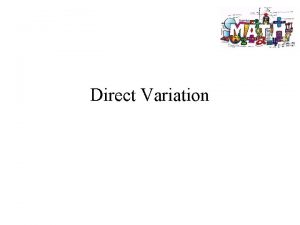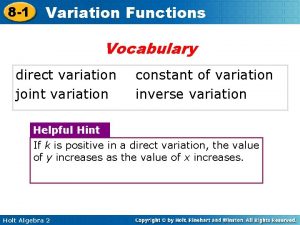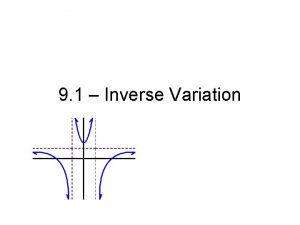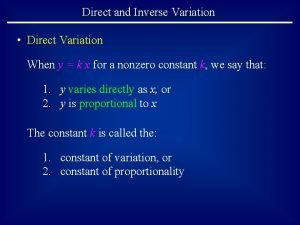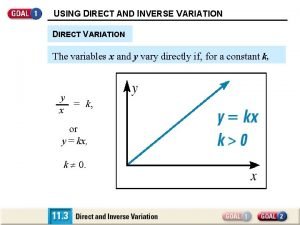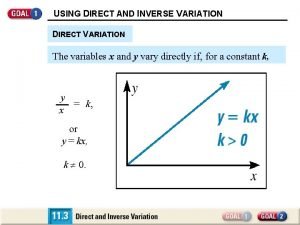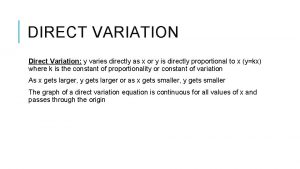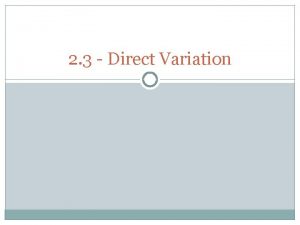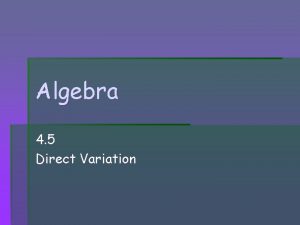Direct Variation What is it and how do




















- Slides: 20

Direct Variation What is it and how do I know when I see it?

Definition: Y varies directly as x means that y = kx where k is the constant of variation. (see any similarities to y = mx + b? ) Another way of writing this is k = In other words: * As X increases in value, Y increases or * As X decreases in value, Y decreases.

Examples of Direct Variation: Note: X increases, 6, 7, 8 And Y increases. 12, 14, 16 What is the constant of variation of the table above? Since y = kx we can say Therefore: 12/6=k or k = 2 14/7=k or k = 2 16/8=k or k =2 Note k stays constant. y = 2 x is the equation!

Examples of Direct Variation: Note: X decreases, 30, 15, 9 And Y decreases. 10, 5, 3 What is the constant of variation of the table above? Since y = kx we can say Therefore: 30/10=k or k = 3 15/5=k or k = 3 9/3=k or k =3 Note k stays constant. y = 3 x is the equation!

Examples of Direct Variation: Note: X decreases, -4, -16, -40 And Y decreases. -1, -4, -10 What is the constant of variation of the table above? Since y = kx we can say Therefore: -1/-4=k or k = ¼ -4/-16=k or k = ¼ -10/-40=k or k = ¼ Note k stays constant. y = ¼ x is the equation!

What is the constant of variation for the following direct variation? 2 -2 -½ ½ 1. 2. 3. 4. Answer Now 1 2 3 4 5 6 7 8 9 10 11 12 21 22 23 24 25 26 27 28 29 30 31 32 13 14 15 16 17 18 19 20

Is this a direct variation? If yes, give the constant of variation (k) and the equation. Yes! k = 6/4 or 3/2 Equation? y = 3/2 x

Is this a direct variation? If yes, give the constant of variation (k) and the equation. Yes! k = 25/10 or 5/2 k = 10/4 or 5/2 Equation? y = 5/2 x

Is this a direct variation? If yes, give the constant of variation (k) and the equation. No! The k values are different!

Which of the following is a direct variation? A B C D 1. 2. 3. 4. Answer Now 1 2 3 4 5 6 7 8 9 10 11 12 21 22 23 24 25 26 27 28 29 30 31 32 13 14 15 16 17 18 19 20

Which is the equation that describes the following table of values? y = -2 x y = 2 x y= ½x xy = 200 1. 2. 3. 4. Answer Now 1 2 3 4 5 6 7 8 9 10 11 12 21 22 23 24 25 26 27 28 29 30 31 32 13 14 15 16 17 18 19 20

Using Direct Variation to find unknowns (y = kx) Given that y varies directly with x, and y = 28 when x=7, Find x when y = 52. HOW? ? ? 2 step process 1. Find the constant variation k = y/x or k = 28/7 = 4 k=4 2. Use y = kx. Find the unknown (x). 52= 4 x or 52/4 = x x= 13 Therefore: X =13 when Y=52

Using Direct Variation to find unknowns (y = kx) Given that y varies directly with x, and y = 3 when x=9, Find y when x = 40. 5. HOW? ? ? 2 step process 1. Find the constant variation. k = y/x or k = 3/9 = 1/3 K = 1/3 2. Use y = kx. Find the unknown (x). y= (1/3)40. 5 y= 13. 5 Therefore: X =40. 5 when Y=13. 5

Using Direct Variation to find unknowns (y = kx) Given that y varies directly with x, and y = 6 when x=-5, Find y when x = -8. HOW? ? ? 2 step process 1. Find the constant variation. k = y/x or k = 6/-5 = -1. 2 k = -1. 2 2. Use y = kx. Find the unknown (x). y= -1. 2(-8) Therefore: x= 9. 6 X =-8 when Y=9. 6

Using Direct Variation to solve word problems Problem: Step One: Find points in table A car uses 8 gallons of gasoline to travel 290 miles. How much gasoline will the car use to travel 400 miles? Step Two: Find the constant variation and equation: k = y/x or k = 290/8 or 36. 25 y = 36. 25 x Step Three: Use the equation to find the unknown. 400 =36. 25 x 36. 25 or x = 11. 03

Using Direct Variation to solve word problems Problem: Step One: Find points in table. Julio wages vary directly as the number of hours that he works. If his wages for 5 hours are $29. 75, how much will they be for 30 hours Step Two: Find the constant variation. k = y/x or k = 29. 75/5 = 5. 95 Step Three: Use the equation to find the unknown. y=kx y=5. 95(30) or Y=178. 50

Direct Variation and its graph y = mx +b, m = slope and b = y-intercept With direction variation the equation is y = kx Note: m = k or the constant and b = 0 therefore the graph will always go through…

the ORIGIN!!!!!

Tell if the following graph is a Direct Variation or not. No No Yes No

Tell if the following graph is a Direct Variation or not. No Yes No
 Direct variation constant of variation
Direct variation constant of variation Direct and inverse graphs
Direct and inverse graphs Coefficient of determination formula in regression
Coefficient of determination formula in regression (x+y)^4
(x+y)^4 Inverse variation graph
Inverse variation graph What is the difference between direct and inverse variation
What is the difference between direct and inverse variation Inverse variation
Inverse variation Equation of direct variation
Equation of direct variation Direct variation as a power
Direct variation as a power Direct variation formula
Direct variation formula Direction variation equation
Direction variation equation In the equation m v p t m represents
In the equation m v p t m represents Direct equation
Direct equation Tell whether the equation represents direct variation
Tell whether the equation represents direct variation Direct variation equation
Direct variation equation Direct variation equation
Direct variation equation What is a direct variation
What is a direct variation What is constant of proportionality
What is constant of proportionality Joint variation table of values
Joint variation table of values Direct variation relationship
Direct variation relationship Direct variation poster
Direct variation poster



